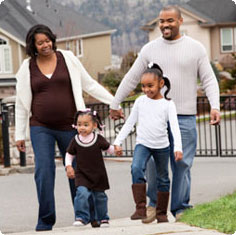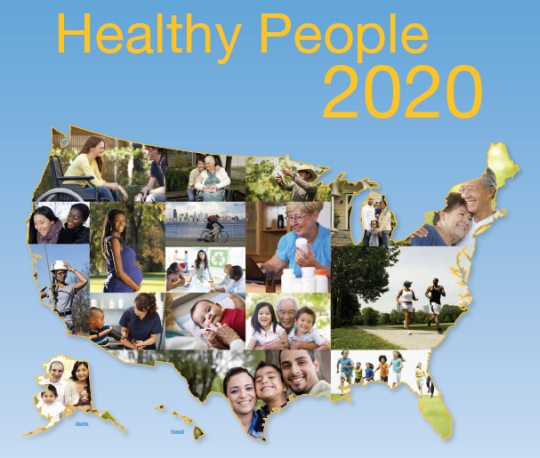Healthy People 2020. Implementing Healthy People 2020.
Sections for Healthy People 2020
- Healthy People 2020
- Healthy People 2020. Overview.
- Healthy People 2020. Topics & Objectives.
- Healthy People 2020. Implementing Healthy People 2020.
- Healthy People 2020. Consortium & Partners.
- Healthy People 2020. Stay Connected.
- Healthy People 2020. Leading Health Indicators (LHI).
Healthy People 2020. Implementing Healthy People 2020.
MAP-IT: A Guide To Using Healthy People 2020 in Your Community
Healthy People is based on a simple but powerful model:
- Establish national health objectives.
- Provide data and tools to enable States, cities, communities, and individuals across the country to combine their efforts to achieve them.
 A Framework for Implementation
A Framework for Implementation
No two public health interventions are exactly alike. But most interventions share a similar path to success:Mobilize, Assess, Plan, Implement, Track.
Otherwise known as MAP-IT, this framework can be used to plan and evaluate public health interventions to achieve Healthy People 2020 objectives. Whether you are a seasoned public health professional or new to the field, the MAP-IT framework will help you create your own path to a healthy community and a healthier Nation.
Use these tools and resources as a reference. Each of the 5 MAP-IT sections includes questions to ask and answer, a brief overview, Healthy People 2020 tools, and links to related resources.
Questions To Ask and Answer:
- What is the vision and mission of the coalition?
- Why do I want to bring people together?
- Who should be represented?
- Who are the potential partners (organizations and businesses) in my community?
Start by mobilizing key individuals and organizations into a coalition.
Look for partners who have a stake in creating healthy communities and who will contribute to the process. Aim for broad representation.
Next, identify roles for partners and assign responsibilities.
This will help to keep partners engaged in the coalition. For example, partners can:
- Facilitate community input through meetings, events, or advisory groups.
- Develop and present education and training programs
- Lead fundraising and policy initiatives.
- Provide technical assistance in planning or evaluation.

Field Notes: Minnesota
Minnesota formed the Minnesota Health Improvement Partnership, a group of individuals representing a broad sector of both public and private organizations, including members from local departments of health. This group was charged with the responsibility to develop Healthy Minnesotans: Public Health Improvement Goals for 2004.
Resources to Help You Mobilize:
- The Community Toolbox
- Chapter 1: Our Model for Community Change and Improvement
- Chapter 4: Getting Issues on the Public Agenda
- Chapter 5: Choosing Strategies to Promote Community Health and Development
- Chapter 7: Encouraging Involvement in Community Work
- Chapter 16: Group Facilitation and Problem-Solving
- Chapter 23: Modifying Access, Barriers, and Opportunities
- Chapter 27: Cultural Competence in a Multicultural World
Toolkits
Questions To Ask and Answer:
- Who is affected and how?
- What resources do we have?
- What resources do we need?
Assess both needs and assets (resources) in your community.
This will help you get a sense of what you can do, versus what you would like to do.
Work together as a coalition to set priorities.
What do community members and key stakeholders see as the most important issues? Consider feasibility, effectiveness, and measurability as you determine your priorities.
Start collecting State and local data to paint a realistic picture of community needs.
The data you collect during the assessment phase will serve as baseline data. Baseline data provide information you gather before you start a program or intervention. They allow you to track your progress.
Dig Deeper: Getting at the Roots of the Issue
Social Determinants of Health
Start a dialogue about the underlying causes of poor health or quality of life in your community. How do the 5 social determinants of health discussed in Healthy People relate to your issue(s)?
- How does the physical environment affect the health of your community? (for example: water and air quality, availability of safe walking paths or sidewalks, housing standards)
- How does access to health services affect the health of your community?
- How do biology and genetics affect the health issue you are trying to address?
- How does the social environment affect the health of your community? (for example: income level, education level, unemployment, language)
- How does individual behavior affect the health issue you are trying to address?
Are there interventions and/or strategies to effect change at the root level, ultimately improving the health of the community?
 Field Notes: Kansas
Field Notes: Kansas
Kansas determined priority health issues through its Healthy Kansas 2000 Steering Committee, which evaluated health data, sought expert opinions, invited public comments, and conducted an opinion survey of residents. Kansas used a consensus method to limit the scope of its objectives to 7 priority health areas and 4 disease risk factors. The 7 priority health areas included alcohol and drug abuse, cancer, heart disease, HIV and other sexually transmitted diseases, infectious diseases and immunizations, injuries and violence, and maternal and infant health. The focal risk factors were lack of access to preventive care, tobacco use, poor nutrition, and lack of physical activity.
Other Resources:
Toolkits
Questions To Ask and Answer:
- What is our goal?
- What do we need to do to reach our goal? Who will do it?
- How will we know when we have reached our goal?
A good plan includes clear objectives and concrete steps to achieve them.
The objectives you set will be specific to your issue or community; they do not have to be exactly the same as the ones in Healthy People 2020.
Consider your intervention points
Where can you create change?
Think about how you will measure your progress.
How will you know if you are successful?
When setting objectives, remember to state exactly what is to be achieved.
What is expected to change, by how much, and by when? Make your objectives challenging, yet realistic.
Remember: Objectives need a target. A target is the desired amount of change (reflected by a number or percentage). A target needs a baseline (where you are now—your first data point).
Making Connections: Achieving Healthy People 2020
Although your objectives are specific to your State or community, it’s important to understand how they support Healthy People 2020. After all, the work you do in your community is part of a larger movement to create a healthier Nation.
Your Objective: Reduce the annual number of new cases of diagnosed diabetes to 8 new cases per 1,000 in Franklin County.
Baseline: 10 new cases per 1,000 population aged 18 to 65 years.
Healthy People Objective: D1: Reduce the annual number of new cases of diagnosed diabetes in the population.
Target: 7.2 new cases per 1,000 population aged 18 to 84 years.
Baseline: 8 new cases of diabetes per 1,000 population aged 18 to 84 years occurred in the past 12 months, as reported in 2006–08 (age adjusted to the year 2000 standard population).
Target setting method: 10 percent improvement.
Data source: National Health Interview Survey (NHIS), Centers for Disease Control and Prevention (CDC), National Center for Health Statistics.

Field Notes: Rhode Island
To achieve its year 2000 objectives, the Rhode Island Department of Health initiated the Worksite Wellness Council of Rhode Island. Rhode Island focused on increasing health promotion and disease prevention activities in work sites, where most adults spend the majority of their time. The State Wellness Council entered into an agreement with the Wellness Council of America (WELCOA) to make Rhode Island the first Well State in the United States. Through this agreement, Rhode Island aims to have 20 percent of its workforce in WELCOA-certified Work Well Sites.
Other Resources:
- State Program Evaluation Guides: Writing SMART Objectives (Centers for Disease Control and Prevention [CDC], 2008)
- State Program Evaluation Guides: Developing and Using a Logic Model (CDC, 2008)
- The Community Toolbox
Toolkits
Questions To Ask and Answer:
- Are we following our plan?
- What can we do better?
First, create a detailed workplan that lays out concrete action steps, identifies who is responsible for completing them, and sets a timeline and/or deadlines.
Make sure all partners are on board with the workplan.
Next, consider identifying a single point of contact to manage the process and ensure that things get done.
Be sure to share responsibilities across coalition members. Do not forget to periodically:
- Bring in new partners for a boost of energy and fresh ideas.
- Check in with existing partners often to see if they have suggestions or concerns.
Get the word out: develop a communication plan.
Convene kick-off events, activities, and community meetings to showcase your accomplishments (and partners).
 Field Notes: North Carolina
Field Notes: North Carolina
North Carolina has established an Office of Healthy Carolinians that is responsible for keeping their Healthy People initiative on track. Staff are available to North Carolina counties for support and training, particularly coalition building. There is also a governor’s task force that certifies counties in the Healthy Carolinians project. The counties do an assessment and then implement an action plan.
Other Resources:
- Pink Book—Making Health Communication Programs Work (National Cancer Institute [NCI], 2002)
- The Community Toolbox
- Chapter 6: Promoting Interest in Community Issues
- Chapter 10: Hiring and Training Key Staff of Community Organizations
- Chapter 11: Recruiting and Training Volunteers
- Chapter 12: Providing Training and Technical Assistance
- Chapter 24: Improving Services
- Chapter 25: Changing Policies
- Chapter 26: Changing the Physical and Social Environment
- Chapter 43: Managing Finances
- Chapter 45: Social Marketing of Successful Components of the Initiative
Toolkits
Questions To Ask and Answer:
- Are we evaluating our work?
- Did we follow the plan?
- What did we change?
- Did we reach our goal?
Plan regular evaluations to measure and track your progress over time.
Consider partnering with a local university or State center for health statistics to help with data tracking. Some things to think about when you are evaluating data over time:
- Data Quality: Be sure to check for standardization of data collection, analysis, and structure of questions.
- Limitations of Self-Reported Data: When you are relying on self-reported data (such as exercise frequency or income), be aware of self-reporting bias.
- Data Validity and Reliability: Watch out for revisions of survey questions and/or the development of new data collection systems. This could affect the validity of your responses over time. (Enlist a statistician to help with validity and reliability testing.)
- Data Availability: Data collection efforts are not always performed on a regular basis.
If you see a positive trend in data, issue a press release or announcement.
 Field Notes: New Jersey
Field Notes: New Jersey
For its 1996 and 1999 updates to the State’s year 2000 objectives, New Jersey’s statistical and program staff assessed progress and analyzed trends. Based on their trend analysis, staff categorized each objective and subobjective as “likely to be achieved,” “unlikely to be achieved,” or “uncertain.”
Other Resources:
- State Program Evaluation Guides: Developing an Evaluation Plan (Centers for Disease Control and Prevention [CDC], 2008)
- The Community Toolbox
Toolkit
> Healthy People 2020. Planning Resources.
Use these resources from the Federal government to help plan your public health intervention. You will find additional links to specific planning and tools and resources throughout the MAP-IT sections.
Centers for Disease Control and Prevention’s (CDC) Health Impact Assessment
CDC’s Healthy Communities Program
Healthy People 2020 program planning tools [PDF – 551 KB]
U.S. Department of Health and Human Services (HHS)
- View the organizational chart of HHS offices and agencies
- View the complete list of HHS offices and agencies
State Healthy People Plans
See a selection of State plans based on Healthy People 2010
Use the resources below to help guide your search for funding.
Grants.gov
Grants.gov is a central clearinghouse managed by the U.S. Department of Health and Human Services with information on more than 1,000 grant programs and provides access to approximately $500 billion in annual awards.
Search grants.gov for funding opportunities.
Other Federal Funding Resources
- Catalog of Federal Domestic Assistance
- U.S. Department of Education
- Department of Health and Human Services (HHS)
- U.S. Department of Housing and Urban Development (HUD)
- Environmental Protection Agency (EPA)
- Federal Business Opportunities
- A Guide to Funding Resources by the U.S. Department of Agriculture (USDA)
> Healthy People 2020. Funding Resources.
Using Healthy People To Make the Case for Funding
- Get the data. Use Healthy People as a data source to support applications for grants or other funding opportunities.
- See how you measure up. Compare your city or State to national baseline data in Healthy People.
- Connect to something larger. Tie your local health promotion efforts to a national public health movement.
- Identify new stakeholders and partners. Make connections across Healthy People topic areas or with professionals working in other States.
- Plan a strong public health program. Healthy People provides a framework for planning, goal setting, and agenda building.
Healthy People Funding Opportunity Archive
Healthy People 2020 Community Innovations Project
- Download the RFP [PDF – 206 KB]
- Download the RFP [PDF – 106 KB]
- Review the Bidders’ Conference Questions and Answers Transcript
(June 27, 2011) [PDF – 434 KB]
Healthy People 2020 Action Project
- View the list of awarded projects [PDF – 116 KB]
- Download the RFP [PDF – 95 KB]
- Download the RFP [Word – 127 KB]
Use the resources below to help guide your search for funding.
Grants.gov
Grants.gov is a central clearinghouse managed by the U.S. Department of Health and Human Services with information on more than 1,000 grant programs and provides access to approximately $500 billion in annual awards.
Search grants.gov for funding opportunities.
Other Federal Funding Resources
- Catalog of Federal Domestic Assistance
- U.S. Department of Education
- Department of Health and Human Services (HHS)
- U.S. Department of Housing and Urban Development (HUD)
- Environmental Protection Agency (EPA)
- Federal Business Opportunities
- A Guide to Funding Resources by the U.S. Department of Agriculture (USDA)
RSS Feeds
You can sign up for RSS feeds to get the latest funding announcements and information.
Funding-related RSS Feeds are available from the following Government Agencies:
- U.S. Department of Housing and Urban Development (HUD)
- U.S. Department of Education
- Environmental Protection Agency (EPA)
- Grants.gov
Or you can view a listing of all .gov RSS feeds
> Healthy People 2020. State Plans.
State and Territorial Healthy People Plans
Many States and Territories use Healthy People as a guide to improving health. Find your State or Territory below to review plans and reports based on objectives and targets from Healthy People.
Each State and Territory has a Healthy People Coordinator who serves as a liaison with the Office of Disease Prevention and Health Promotion (ODPHP). The Coordinator ensures that the development of the plan is in line with Healthy People goals and objectives.
Find the Healthy People Coordinator in your State or Territory
###
* The above information is adapted from materials provided by USA Department of Health and Human Services (HHS)
** More information at USA Department of Health and Human Services (HHS)























